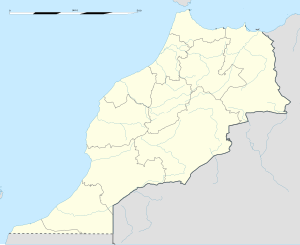Battle of Wadi al-Laban
| Battle of Wadi al-Laban | |||||
|---|---|---|---|---|---|
| |||||
| Belligerents | |||||
|
|
| ||||
| Commanders and leaders | |||||
| Abdallah al-Ghalib | Hasan Pasha | ||||
| Strength | |||||
| Unknown | Unknown | ||||
| Casualties and losses | |||||
| Unknown | Unknown | ||||
Location of the battle of Wadi al-Laban in Morocco. | |||||
The Battle of Wadi al-Laban, also Battle of Oued el Leben,معركة وادي اللبن occurred in March–April 1558 between Saadians and Turkish-Algerian forces under Hasan Pasha, the son of Hayreddin Barbarossa and occurred north of Fes, at Wadi al-Laban ("The riverbed of milk" or "The riverbed of yoghurt"[1]), an affluent of the Sebou River, one day north of Fes.[2]
Background
This conflict took place in a context of tensions between Algeria and Morocco.[3][4][5] until the return of the Saadian Mohammed ash-Sheikh to power. Following the return of the Saadians, numerous conflicts broke out between Algeria and Morocco, which tried to annex the Algerian city of Tlemcen.[6]
The conflict was initiated when the Moroccan ruler Mohammed ash-Sheikh refused to give allegiance to the Ottomans and the alliance he concluded with the Spaniards.[2] Hasan Pasha, the son of Barbarossa, was named by the Ottoman Empire beylerbey of the Regency of Algiers in June 1557, in order to continue the fight against the Moroccan ruler. He had Mohammed ash-Sheikh assassinated in October 1557 by one of his bodyguards.[2]
Battle
The Ottoman turks who were backing the Wattasid sent an invasion force into morocco led by the ruler of Algiers Hasan Pasha, the son of khizr barbarossa,[1] [7]then he conquered Fes in September 1554.[8] An indecisive battle between the two sides took place in Wadi al-Laban to the north of Fez,[9][10][11] after which, Hasan Pasha decided to retreat upon hearing of Spanish preparations for an offensive from Oran in Western Algeria.[9][12] He embarked with his troops at the port of Qassasa in northern Morocco, just west of Melilla, and from there sailed to Algiers to prepare a defense against the Spaniards, who soon attacked in the Mostaganem expedition.[2] Other sources attribute a victory to either Hassan[13] or Abdallah.[14]
Aftermath
Abdallah al-Ghalib later sent an expedition against Tlemcen in 1560 but it was defeated.[15][16] Despite his initial opposition against the Ottomans, later during his reign Abdallah al-Ghalib was forced to pay an annual tribute of vassalage to the Ottomans therefore establishing Ottoman influence on the entire Maghreb.[17][18][19]
See also
Notes
- ^ a b Elgibali, Alaa (2005). Investigating Arabic: Current Parameters in Analysis and Learning. BRILL. p. 58. ISBN 9004137920.
- ^ a b c d Jamil M. Abun-Nasr (20 August 1987). A History of the Maghrib in the Islamic Period. Cambridge University Press. pp. 157–158. ISBN 978-0-521-33767-0.
- ^ Véronne, Chantal de La (1997-01-01). Histoire sommaire des Sa'diens au Maroc: La première dynastie chérifienne, 1511-1659 (in French). FeniXX réédition numérique. ISBN 978-2-307-06107-6.
- ^ Cour, Auguste (2004-09-10). L'établissement des dynasties des Chérifs au Maroc et leur rivalité avec les Turcs de la Régence d'Alger, 1509-1830 (in French). Editions Bouchène. ISBN 978-2-35676-097-5.
- ^ Péchot, L. (1914). Histoire de l'Afrique du Nord avant 1830: précédée de la géographie physique et politique de la Tunisie, de l'Algérie et du Maroc (in French). Gojosso.
- ^ De La Veronne, Chantal (1973). "Relations entre le Maroc et la Turquie dans la seconde moitié du XVIe siècle et le début du XVIIe siècle (1554-1616)". Revue des mondes musulmans et de la Méditerranée. 15 (1): 391–401. doi:10.3406/remmm.1973.1258.
- ^ Konstam, Angus (2016-08-25). The Barbary Pirates 15th-17th Centuries. Bloomsbury Publishing. ISBN 978-1-4728-1544-6.
- ^ Abun-Nasr, Jamil M.; al-Naṣr, Ǧamīl M. Abū; Abun-Nasr, Abun-Nasr, Jamil Mirʻi (1987-08-20). A History of the Maghrib in the Islamic Period. Cambridge University Press. ISBN 978-0-521-33767-0.
- ^ a b A history of the Maghrib in the Islamic period by Jamil M. Abun-Nasr p.157ff
- ^ Konstam, Angus (2016-08-25). The Barbary Pirates 15th-17th Centuries. Bloomsbury Publishing. ISBN 978-1-4728-1545-3.
- ^ Stapleton, Timothy J. (2013-10-21). A Military History of Africa [3 volumes]. ABC-CLIO. ISBN 978-0-313-39570-3.
- ^ Charles André Julien (1970). History of North Africa: Tunisia, Algeria, Morocco, from the Arab Conquest to 1830. Routledge & K. Paul. p. 296. ISBN 978-0-7100-6614-5.
- ^ First Encyclopaedia of Islam 1913-1936. BRILL. 1993. p. 281. ISBN 978-90-04-09796-4.
- ^ Véronne, Chantal de La (1997-01-01). Histoire sommaire des Sa'diens au Maroc: La première dynastie chérifienne, 1511-1659 (in French). FeniXX réédition numérique. ISBN 978-2-307-06107-6.
- ^ The Last Crusaders: East, West and the Battle for the Centre of the World. Barnaby Rogerson. Hachette UK.
- ^ History of Islam: Classical period, 1206-1900 C.E. Masudul Hasan. Adam Publishers & Distributers.
- ^ La bataille de l'Oued el-Makhâzen: dite bataille des Trois Rois (4 aout 1578). P.196. Pierre Berthier. Editions du Centre national de la recherche scientifique
- ^ al-Ḥayāh al-iqtiṣādīyah lil-wilāyāt al-ʻArabīyah wa-maṣādir wathāʼiqihā fī al-ʻahd al-ʻUthmānī, Volume 3. P.107. Markaz al-Dirāsāt wa-al-Buḥūth ʻan al-Wilāyāt al-ʻArabīyah fī al-ʻAhd al-ʻUthmānī,
- ^ مجلة التاريخية المغربية Issues 37-40 Imprimerie de l'UGTT.
- CS1 French-language sources (fr)
- Articles with short description
- Short description with empty Wikidata description
- Coordinates not on Wikidata
- Conflicts in 1558
- Battles involving the Ottoman Empire
- Battles involving Morocco
- Suleiman the Magnificent
- 1558 in the Ottoman Empire
- 16th century in Morocco
- 16th century in Algeria
- 1558 in Africa
